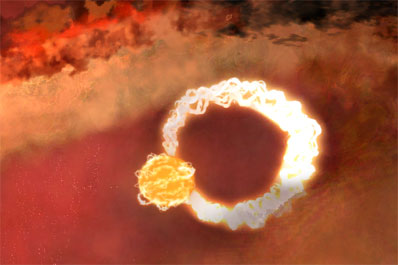 © Chandra / E Feigelson
© Chandra / E Feigelson
Introduction
Whereas the understanding of most phases of stellar evolution made considerable progress throughout the whole of the twentieth century, stellar formation remained rather enigmatic and poorly constrained by observations until about three decades ago. One of the major discoveries obtained at this time is that protostellar accretion discs are often associated with extremely powerful and highly collimated jets escaping the disc along its rotation axis (eg Burrows et al, 2006, ApJ 473, 437). This finding has revolutionized the field of stellar formation; in particular, it very strongly suggested that magnetic fields are playing a major role throughout stellar formation (Pudritz & Norman, 1983, ApJ 274, 677).
MaPP concentrates mostly on the following goals.
Magnetised collapse & accretion disc
Using Doppler tomography on time-resolved spectropolarimetric observations of protostellar accretion discs, MaPP can produce charts of density and magnetic field in the core regions of the disc (eg Donati et al 2005, Nature 438, 466). By comparing with results from numerical simulations of molecular cloud collapse in the presence of magnetic fields (eg Banerjee & Pudritz 2006, ApJ 641, 949; Hennebelle & Fromang 2008, A&A 477, 9), MaPP should reveal the origin of magnetic fields in accretion discs and indicate whether it is a fossil remnant or a dynamo output. MaPP will also check whether the field is indeed capable of enhancing accretion through disc instabilities (eg Balbus & Hawley 2003, LNP 614, 329) and of inhibiting the formation of protostellar/protoplanetary clumps in the disc (eg Fromang 2005, A&A 441, 1).
Radio observations - with ALMA in particular - will reveal magnetic fields in molecular clouds and outer accretion discs, nicely complementing the information we will derive from spectropolarimetric data. This will help to constrain the existing magnetised collapse models (eg Machida et al 2007, ApJ 670, 1198) and to estimate how much magnetic flux survives ohmic dissipation.
Magnetospheric accretion and stellar structure
By using Zeeman-Doppler imaging on sets of spectropolarimetric observations of classical T Tauri stars (cTTSs), MaPP provides detailed views of magnetic structures at the surface of newly born stars (eg Donati et al 2007, MNRAS 380, 1297; Donati et al 2008, MNRAS 386, 1234). These maps tell us how magnetic fields connect the star to the accretion disc and how disc material is transferred to the star through magnetospheric accretion processes (eg Jardine et al 2006, MNRAS 367, 917). Global 3D simulations of disc accretion to rotating magnetised stars successfully captured many aspects of magnetospheric flows, using simple field configurations (tilted dipole, Romanova et al 2003, ApJ 595, 1009; tilted dipole+quadrupole, Long, Romanova & Lovelace, 2007, ApJ MNRAS 374, 436). Future simulations will use more realistic magnetospheric topologies derived from observed surface magnetic maps of cTTSs and will produce realistic spectra of emission lines formed in accretion funnels, to be compared with observations (eg Kurosawa, Romanova, Harries 2008, MNRAS 385, 1931).
X-ray observations also inform on magnetic topologies of low-mass protostars; in particular, they show that the coronal emission from low-mass protostars is lower that those of active stars of similar spectral type and rotation rate on the main sequence, accreting protostars showing even smaller X-rays than non-accreting protostars (eg Preibisch et al 2005, ApJS 160, 401). Recording simultaneous X-ray observations and spectropolarimetric monitoring on a sample of protostars and producing models reproducing consistently the trends revealed by the data (eg Jardine et al 2006, MNRAS 367, 917, Gregory et al 2007, MNRAS 379, L35) will help providing a better description of the 3D magnetospheric geometry and magnetospheric accretion processes in low-mass protostars.
Jets & giant close-in protoplanets
Using the disc and magnetic field structure derived from observations, MaPP can help testing and updating existing theoretical models of collimated jet and wind formation from young stars and/or their accretion discs (eg Ferreira et al 2006, A&A 453, 785) and try to work out the role of magnetic fields in controlling the disc ability to fire jets and winds (eg Ménard & Duchène 2004, A&A 425, 973).
MaPP can also search for density gaps in accretion discs, potentially indicating the presence of close-in giant planets around newly born stars. By looking at how gaps spatially correlate with magnetic topologies, we can check whether magnetic fields are capable of stopping giant protoplanets in their inward spiral migration (eg Terquem 2003, MNRAS 341, 1157). Migrating planets may also survive by entering the low-density magnetospheric gaps that magnetised protostars forming dig at the centre of accretion discs; simulations can help testing this option more quantitatively (Romanova & Lovelace 2006, ApJ 645, L73).
Internal structure & angular momentum evolution
MaPP can also help exploring how accretion processes and magnetic fields impact the structure of the forming star (eg by inhibiting convection and mixing where the field is strong, Mullan & Mac Donald, 2001, ApJ 559, 353; Gallardo, Chabrier & Baraffe, 2007, A&A 472, L17) and how they affect the angular momentum history (eg Long, Romanova & Lovelace, 2005, ApJ 634, 1214).
Magnetic topologies of disc-less T Tauri stars can reveal how efficiently young stars lose their angular momentum (eg Donati et al 2000, MNRAS 316, 699). This angular momentum loss critically depends on how the wind and prominences magnetically couple to the central star (eg Bouvier Forestini Allain 1997, A&A 326, 1023). Magnetic properties of pre-main-sequence and zero-age-main-sequence stars with different ages, masses and rotation rates (eg Feigelson et al 2004, ApJ 611, 1107) are crucial for such studies.
 MaPP
MaPP